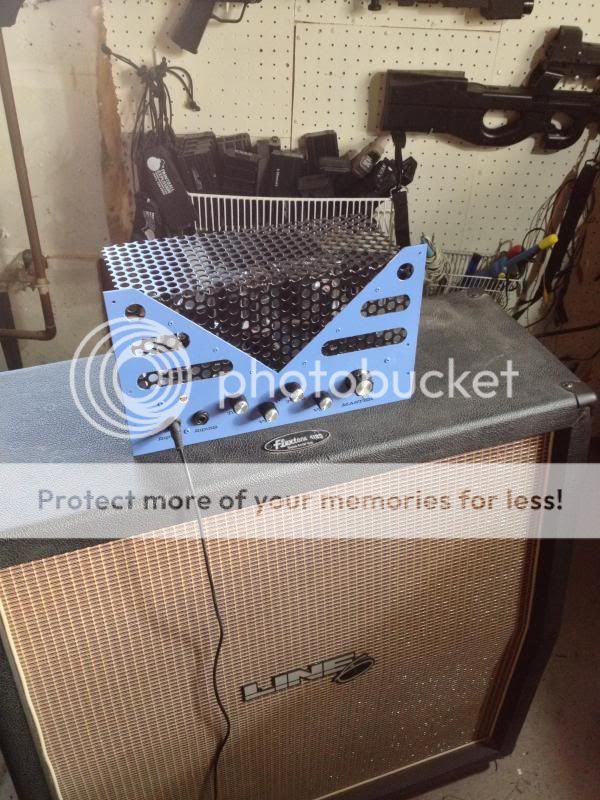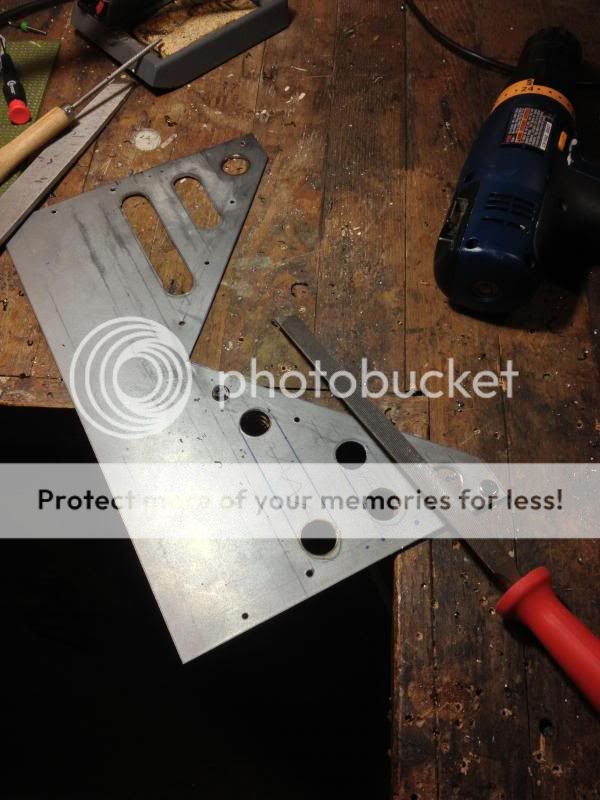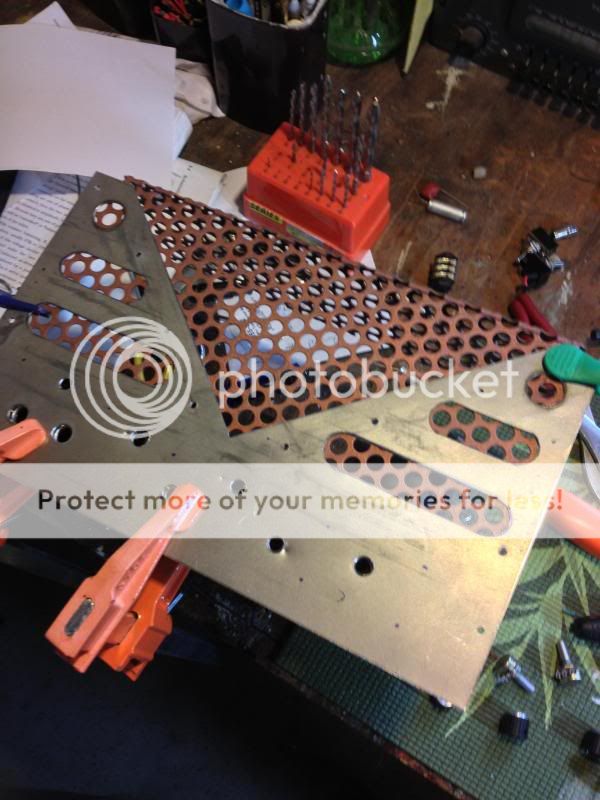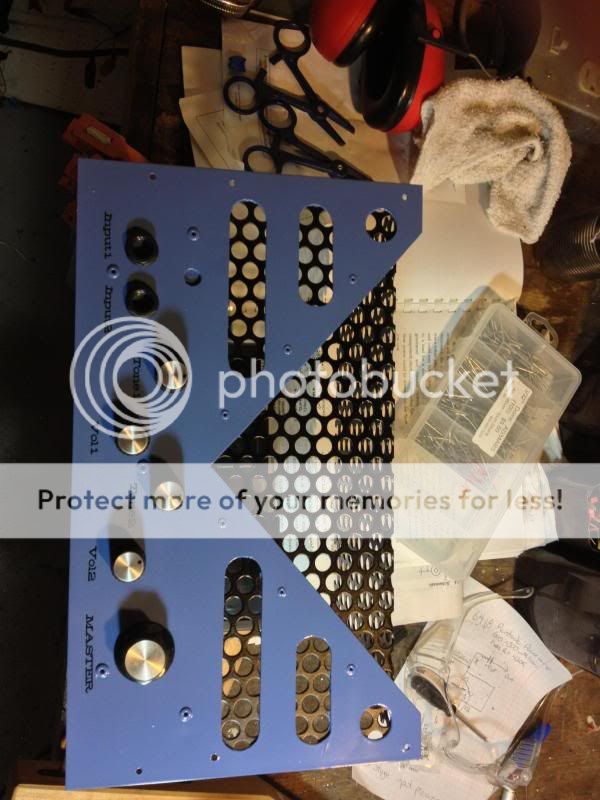Hi all.
Here is a a Single Ended guitar amp that i put together for a friend.
He is looking for a cleaner ,country kinda sound, so i put together this schematic from a variety of others,on the net. it is up & works great..but I may tweak a few things.Anyone care to look at the component values & add their opinions ,I would be grateful. I am thinking about increasing some of the series resistance to tame the gain a bit.
Thanks In advance.
View attachment RG6550.pdf
Here is a picture of the chassis ..I still have to build a case for it.

Here is a a Single Ended guitar amp that i put together for a friend.
He is looking for a cleaner ,country kinda sound, so i put together this schematic from a variety of others,on the net. it is up & works great..but I may tweak a few things.Anyone care to look at the component values & add their opinions ,I would be grateful. I am thinking about increasing some of the series resistance to tame the gain a bit.
Thanks In advance.
View attachment RG6550.pdf
Here is a picture of the chassis ..I still have to build a case for it.

Last edited:
Some quick comments (I assume most of these are drawing errors, and not in the actual cicuit):
- remove all the grid to cathode connections (to the bypass caps);
- the EF86 is missing the screen bypass capacitor, typical value is 10n-100nF;
- all the coupling capacitors' (C3, C9, C10, C11) value seem high;
- Volume 2 is mis-wired, the grid should be connected to pin 2 of RV3;
- R13, R14 & R16 are probably typo's - 200K instead of 2K?
- R23, the 470R seem quite high for the 6550, what output transformer are you using?
Cool looking chassis you got, did you make it yourself?
Jaz
- remove all the grid to cathode connections (to the bypass caps);
- the EF86 is missing the screen bypass capacitor, typical value is 10n-100nF;
- all the coupling capacitors' (C3, C9, C10, C11) value seem high;
- Volume 2 is mis-wired, the grid should be connected to pin 2 of RV3;
- R13, R14 & R16 are probably typo's - 200K instead of 2K?
- R23, the 470R seem quite high for the 6550, what output transformer are you using?
Cool looking chassis you got, did you make it yourself?
Jaz
Thanks for looking at the schematic .i didn't realize there where so many errors.Some quick comments (I assume most of these are drawing errors, and not in the actual cicuit):
- remove all the grid to cathode connections (to the bypass caps);
- the EF86 is missing the screen bypass capacitor, typical value is 10n-100nF;
- all the coupling capacitors' (C3, C9, C10, C11) value seem high;
- Volume 2 is mis-wired, the grid should be connected to pin 2 of RV3;
- R13, R14 & R16 are probably typo's - 200K instead of 2K?
- R23, the 470R seem quite high for the 6550, what output transformer are you using?
Cool looking chassis you got, did you make it yourself?
Jaz
Most of what you listed where schematic errors except.....
I don't have a screen bypass cap for the EF86. Will look into that .
The bypass caps could be high but I don't seem to notice a problem.
I don't think R13 , R14 & R16 are typos ,,,I prolly should raise them.
R23 is high,but I am purposely bias the 6550 pretty cold . The power tranny seems happeir that way.I salvage the chassis ,and trannys of an old Stromberg Carlson tube amp. (SE 10watt 6L6). I am just using the 6550 for its 'stiffer' sound.I did make the front panels from scratch.I will post sum pics of that process soon, but 1st; I have a schematic to edit.

Ok..
Here is the updated schematic....View attachment RB6550.pdf
I fixed the errors ,also I updated it to reflect changes I made in the actual amp.
Here some pictures of the face plate build....
Take one sheet of aluminum,,,add lots of elbow grease...

Bend a piece of perforated metal ...

Paint them pretty colors....

Then rivet the whole mess together....

I used a laser printer to make clear water transfers ,to label the front panel....

Here is the updated schematic....View attachment RB6550.pdf
I fixed the errors ,also I updated it to reflect changes I made in the actual amp.
Here some pictures of the face plate build....
Take one sheet of aluminum,,,add lots of elbow grease...

Bend a piece of perforated metal ...

Paint them pretty colors....

Then rivet the whole mess together....

I used a laser printer to make clear water transfers ,to label the front panel....

So .. What are some of the implications of make the coupling caps too large. Tubey bass? Blocking distrotions?
I really like what you did with the front panel - it really stands out - not like your typical tolex-on-a-piece-of-wood construction... Yes if the coupling capacitors are too large, the they are likely to cause blocking distortion - but if you don't hear it now, then you can just leave them alone.
Jaz
Jaz
I really like what you did with the front panel - it really stands out - not like your typical tolex-on-a-piece-of-wood construction... Yes if the coupling capacitors are too large, then they are likely to cause blocking distortion - but if you don't hear it now, then you can probably just leave them alone.
Jaz
Jaz
disclaimer: I'm just a hack...YMMV
c 3,9,10, 11 are not bypass caps, they're interstage coupling caps. Large values just carry a bit more bass, at risk of some grid-blocking if you're overdriving (and possibly wasting some of the limited power on string movements below the frequencies of interest). For your country-clean objective it might be OK, but if (when dirty) the volume ducks and recovers with a slow swell, reducing the bass thry the coupling caps may help. If he doesn't use boost pedals, you might be fine if if sounds good to you, especailly for D-tuned texas guitar or baritone guitar.
Assuming your power supply was up to it, you could switch the two channels one stage earlier than where you mix them now. That would save a stage and switching instead of mixing would add some gain, and you wouldn't need a dual pot. Then you could use that 'extra' stage (which you saved from duplicating in both channels) direct-coupled for more current to drive a pair of 6550's and a speaker load with a lower impedance. That would get you louder before breakup, another way of saying "more clean". A relay (or two) and you've got remote channel-switching. But that would be a different amp, and I assume you know what you want.
You want cleaner; is it the preamp or power amp that breaks up first? If you really need more watts, tweeking the preamp won't help.
Usable clean is the dynamic range from noise floor to breakup, so you might work on the noise too. Again, I like swtiching channels instead of mixing, but mixing worked for Fender it can work for you. An efficient low-power speaker with a small voice coil in an open-back cabinet will get twice as loud before breakup. Then you start working on getting rid of all hum. It never ends. Best of luck, have fun.
Now that's a weird tone select to my experience...no slope control
c 3,9,10, 11 are not bypass caps, they're interstage coupling caps. Large values just carry a bit more bass, at risk of some grid-blocking if you're overdriving (and possibly wasting some of the limited power on string movements below the frequencies of interest). For your country-clean objective it might be OK, but if (when dirty) the volume ducks and recovers with a slow swell, reducing the bass thry the coupling caps may help. If he doesn't use boost pedals, you might be fine if if sounds good to you, especailly for D-tuned texas guitar or baritone guitar.
Assuming your power supply was up to it, you could switch the two channels one stage earlier than where you mix them now. That would save a stage and switching instead of mixing would add some gain, and you wouldn't need a dual pot. Then you could use that 'extra' stage (which you saved from duplicating in both channels) direct-coupled for more current to drive a pair of 6550's and a speaker load with a lower impedance. That would get you louder before breakup, another way of saying "more clean". A relay (or two) and you've got remote channel-switching. But that would be a different amp, and I assume you know what you want.
You want cleaner; is it the preamp or power amp that breaks up first? If you really need more watts, tweeking the preamp won't help.
Usable clean is the dynamic range from noise floor to breakup, so you might work on the noise too. Again, I like swtiching channels instead of mixing, but mixing worked for Fender it can work for you. An efficient low-power speaker with a small voice coil in an open-back cabinet will get twice as loud before breakup. Then you start working on getting rid of all hum. It never ends. Best of luck, have fun.
Now that's a weird tone select to my experience...no slope control
Large coupling caps pass more bass. Depending on the guitar, pickups, and strings, you may be getting more bass than you need. Bass uses up the most of your amps power, hits the OPT harder and takes up the most of your speaker's capability. Reducing the coupling cap size can often allow the amp to play louder, especially if you have a smallish OPT or speaker.
There are places where I use a .1uF or larger coupling cap, especially if the amp has a lot of power, a big OPT and might see a bass guitar or a keyboard. For a guitar only amp, I start with .022 and tweak as needed.
I built several "Turbo Champs" about 15 years ago that used a single 6550 on 430 volts through a Hammond 125CSE. Every one of these was different, just made up as I went along. Many were for my daughters friends. Each one was tweaked with the users guitar and speaker choice. If the user liked two choices, he got them, on a switch. They all got a switch on the OPT to intentionally mismatch the speaker. Most got a tube / solid state rectifier switch, and a switch to add more capacitance to the power supply. Contrary to some opinion, a class A amp isn't class A as soon as you drive it into distortion, so power supply sag does have an effect. The cathode bypass caps were switchable on some amps.
There are places where I use a .1uF or larger coupling cap, especially if the amp has a lot of power, a big OPT and might see a bass guitar or a keyboard. For a guitar only amp, I start with .022 and tweak as needed.
I built several "Turbo Champs" about 15 years ago that used a single 6550 on 430 volts through a Hammond 125CSE. Every one of these was different, just made up as I went along. Many were for my daughters friends. Each one was tweaked with the users guitar and speaker choice. If the user liked two choices, he got them, on a switch. They all got a switch on the OPT to intentionally mismatch the speaker. Most got a tube / solid state rectifier switch, and a switch to add more capacitance to the power supply. Contrary to some opinion, a class A amp isn't class A as soon as you drive it into distortion, so power supply sag does have an effect. The cathode bypass caps were switchable on some amps.
- Status
- Not open for further replies.
- Home
- Live Sound
- Instruments and Amps
- SE 6550 Guitar amp